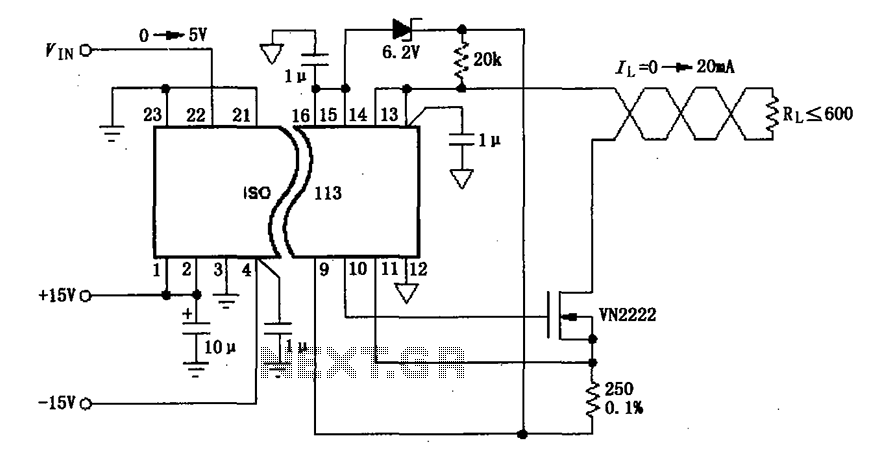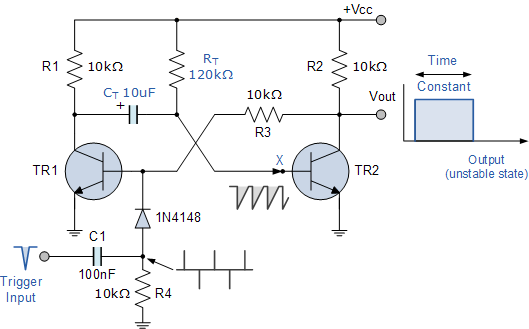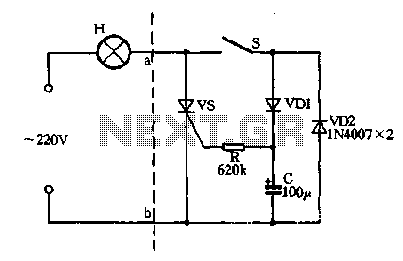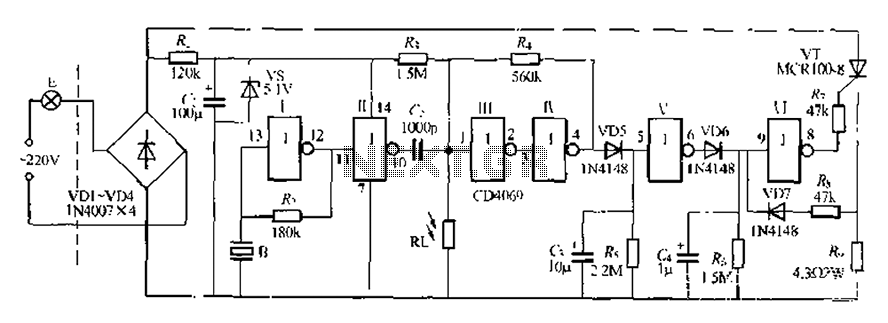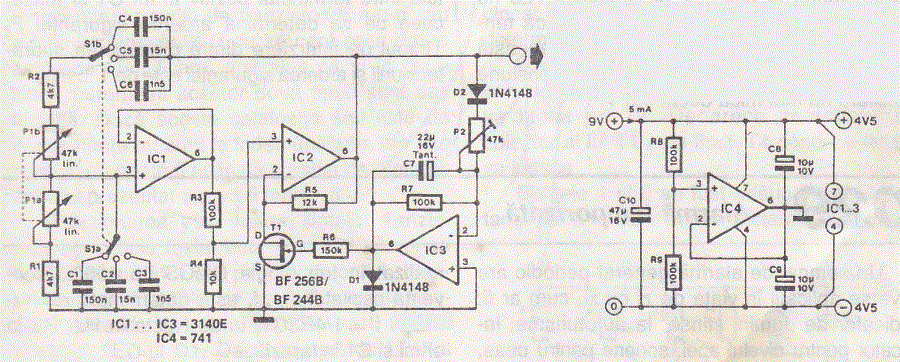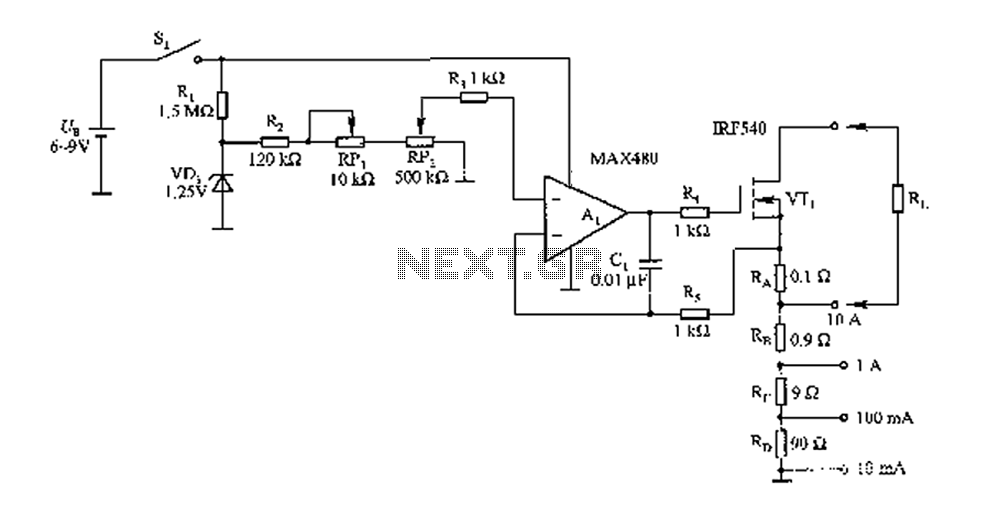
tone control circuit designed
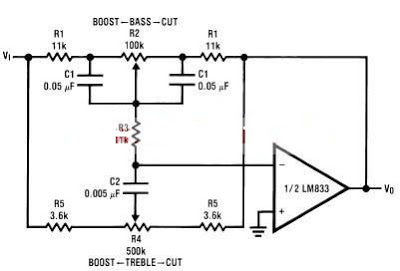
A simple tone control circuit can be designed using the LM833 operational amplifier along with a few external components. The LM833 is a dual general-purpose operational amplifier, specifically optimized for performance in audio applications. This tone control circuit utilizes the LM833 and incorporates two RC filters—one low-pass and one high-pass. The frequency of the tone control circuit can be adjusted using the provided formulas to determine the cutoff frequencies of the RC filters. In the schematic for this tone control circuit, the frequencies are specified as: fL = 32 Hz, fLB = 320 Hz, fH = 11 kHz, and fHB = 1.1 kHz.
The LM833 operational amplifier is well-suited for audio applications due to its low noise and high input impedance characteristics, which help maintain signal integrity. The tone control circuit operates by manipulating the frequency response of an audio signal, allowing users to boost or attenuate specific frequency ranges to achieve desired sound qualities.
The circuit consists of two primary components: the low-pass and high-pass filters. The low-pass filter allows frequencies below a certain cutoff frequency to pass through while attenuating higher frequencies. Conversely, the high-pass filter permits frequencies above a designated cutoff frequency to pass through while reducing lower frequencies. The interaction between these filters provides a means to adjust the tonal quality of the audio signal.
The cutoff frequencies for the filters can be calculated using standard RC filter formulas, which relate the resistance (R) and capacitance (C) values in the circuit to the desired frequency response. The specific values of resistors and capacitors used in the circuit will determine the exact cutoff frequencies. For instance, the low-pass filter cutoff frequency (fL) can be calculated using the formula fL = 1 / (2πRC), where R is the resistance and C is the capacitance. Similarly, the high-pass filter cutoff frequency (fH) is determined using the same formula, adjusting the configuration of the resistors and capacitors accordingly.
In summary, the LM833 tone control circuit is an effective solution for audio applications, providing users with the ability to finely tune their audio experience through the adjustment of specific frequency ranges. By selecting appropriate resistor and capacitor values, the circuit can be tailored to meet various audio requirements, making it a versatile tool for audio engineers and enthusiasts alike.Using LM833 can be designed a very simple tone control circuit using few external components. For this Lm833 ton control circuit can be used almost any type of operational amplifier if it have high input impedance. The LM833 is a is a dual general purpose operational amplifier designed with particular emphasis on performance in audio systems.
The ton control from this circuit is based on this operational amplifier from National Semiconductor and two RC filters ( low pass and high pass ). Using the formula presented bellow we can modify the frequency of the tone control circuit - the cut off frequency of RC filters (low pass and high pass )lm833 tone control formula For the tone control circuit presented in this schematic the frequencies are : fL = 32 Hz, fLB = 320 Hz and fH =11 kHz, fHB = 1.
1 kHz. 🔗 External reference
The LM833 operational amplifier is well-suited for audio applications due to its low noise and high input impedance characteristics, which help maintain signal integrity. The tone control circuit operates by manipulating the frequency response of an audio signal, allowing users to boost or attenuate specific frequency ranges to achieve desired sound qualities.
The circuit consists of two primary components: the low-pass and high-pass filters. The low-pass filter allows frequencies below a certain cutoff frequency to pass through while attenuating higher frequencies. Conversely, the high-pass filter permits frequencies above a designated cutoff frequency to pass through while reducing lower frequencies. The interaction between these filters provides a means to adjust the tonal quality of the audio signal.
The cutoff frequencies for the filters can be calculated using standard RC filter formulas, which relate the resistance (R) and capacitance (C) values in the circuit to the desired frequency response. The specific values of resistors and capacitors used in the circuit will determine the exact cutoff frequencies. For instance, the low-pass filter cutoff frequency (fL) can be calculated using the formula fL = 1 / (2πRC), where R is the resistance and C is the capacitance. Similarly, the high-pass filter cutoff frequency (fH) is determined using the same formula, adjusting the configuration of the resistors and capacitors accordingly.
In summary, the LM833 tone control circuit is an effective solution for audio applications, providing users with the ability to finely tune their audio experience through the adjustment of specific frequency ranges. By selecting appropriate resistor and capacitor values, the circuit can be tailored to meet various audio requirements, making it a versatile tool for audio engineers and enthusiasts alike.Using LM833 can be designed a very simple tone control circuit using few external components. For this Lm833 ton control circuit can be used almost any type of operational amplifier if it have high input impedance. The LM833 is a is a dual general purpose operational amplifier designed with particular emphasis on performance in audio systems.
The ton control from this circuit is based on this operational amplifier from National Semiconductor and two RC filters ( low pass and high pass ). Using the formula presented bellow we can modify the frequency of the tone control circuit - the cut off frequency of RC filters (low pass and high pass )lm833 tone control formula For the tone control circuit presented in this schematic the frequencies are : fL = 32 Hz, fLB = 320 Hz and fH =11 kHz, fHB = 1.
1 kHz. 🔗 External reference
